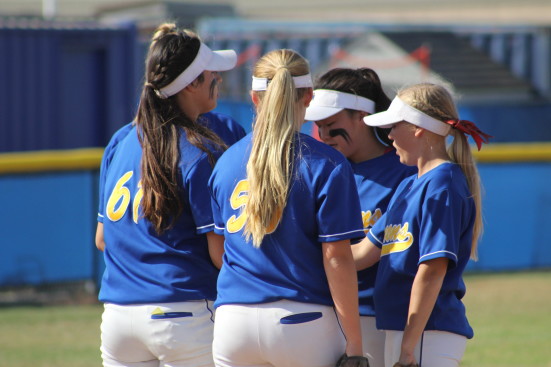
By Charlyne Nguyen
Playing a sport can be a time-consuming and pressure-infused experience for many athletes, but having a huge support system often improves morale.
With many girls’ and women’s sports, however, filling up the stands doesn’t come easily, and that needs to change.
One girls’ sports team at Fountain Valley High School (FVHS) that doesn’t receive much support, for example, is softball. Few students attend girls’ softball games, let alone even know when games are due to a lack of publicity.
“No, I haven’t seen [a game flyer], mainly because I don’t know anyone on the team, and there isn’t any advertising or posters I can easily access on campus or through mutuals,” senior Vanessa Nguyen said when asked about softball advertising.
Without good advertisement, athletes go unnoticed because students often won’t go looking for game dates and events on their own.
“Our [softball game] schedule usually isn’t posted or known, so people have to come and ask us or we have to post,” senior softball player Kiara Palamino said. “In the announcements, you don’t usually hear about softball either.”
The lack of recognition in women’s sports starts early on, often in high school for many girls’ sports like our softball team, and continues in the collegiate and professional sports world. The United States women’s national soccer team (USWNT), for example, is often overlooked.
Despite being four-time FIFA Women’s World Cup champions, even the United State’s beaming hope for soccer doesn’t get the recognition they deserve and consequently doesn’t get paid as much as they should be, considering how they represent the country and the number of world titles they boast.
USWNT female soccer players, for example, get paid only $0.38 of every dollar a United States men’s national soccer team (USMNT) player earns. In the 2015 Women’s FIFA World Cup, the USWNT team generated $20 million more in revenue than the USMNT team but was only paid a quarter of what the men’s team made that same year.
Although the USMNT brought $84.4 million more in revenue than the USWNT between 2009 and 2019, this difference over the course of ten years could be due to the fact that women earn less for the games that they win. Hypothetically, if the USMNT had won the 2018 Men’s FIFA World Cup, they would’ve earned $400 million. When the USWNT won the 2019 FIFA World Cup, they only made $30 million.
With the gender pay gap, female soccer players would have to play more games in order to make as much as male soccer plays, and that’s if there were even more games for them to play.
On top of the pay disparity, viewership for both the men’s and women’s FIFA World Cups show that people around the world would rather watch men play soccer. The 2018 Men’s FIFA World Cup had a 3.572 billion viewership while the 2019 Women’s World Cup only had 1.12 billion viewership.
In previous years, we continue to see men’s viewership numbers dominate. The 2014 FIFA Men’s World Cup drew in 3.2 billion viewers, while the 2015 FIFA Women’s World Cup only drew in 764 million viewers. Similarly, the 2010 FIFA Men’s World Cup brought in about 3.2 billion viewers, while the 2011 FIFA Women’s World Cup only had 63 million.
FIFA Women’s World Cup viewership has increased dramatically over the years, but there’s still room for growth.
The gender pay discrepancy and lack of viewership across many female sports is a major problem because it means that after high school, many female athletes have a hard time paving the way for young athletes. It’s difficult for female athletes to get noticed, which can lead to program cuts, and they aren’t fairly compensated for their talents and commitment, which could lead them to quit early.
“It doesn’t feel right. We shouldn’t be denied the chance to continue playing the sport we love after college just because we are women,” senior softball player Avery Austin said. “Look at our national women’s soccer team. They perform spectacularly, and yet most people just brush their division off as a worse version of men’s soccer. The same thing happens with the WNBA too. It just doesn’t make sense.”
For many students, exposure to sports takes place in their physical education (P.E.) classes, allowing them to gain an understanding of what certain sports are like, but this doesn’t mean they’ll go on through time following upon them.
“P.E. allowed me to experience [softball], and it was similar to baseball but a slight twist, but I don’t know much about our school softball,” senior Kaylee Pham said.
Great advertisement goes a long way in keeping sports instilled in people’s minds despite them not actually playing it anymore.
Although equal pay is not going to come any time soon, estimated to be 100 years by the Goldman Sachs Group, people can start making progress in the sports world for women by being at the games and cheering them on. This can easily start in earlier levels of sports, such as in high school.
“I think every team needs school support because it can really make a difference in how the players play,” softball coach Rick Alrich said. “Knowing you’re supported can give confidence when you know people believe in your team.”





